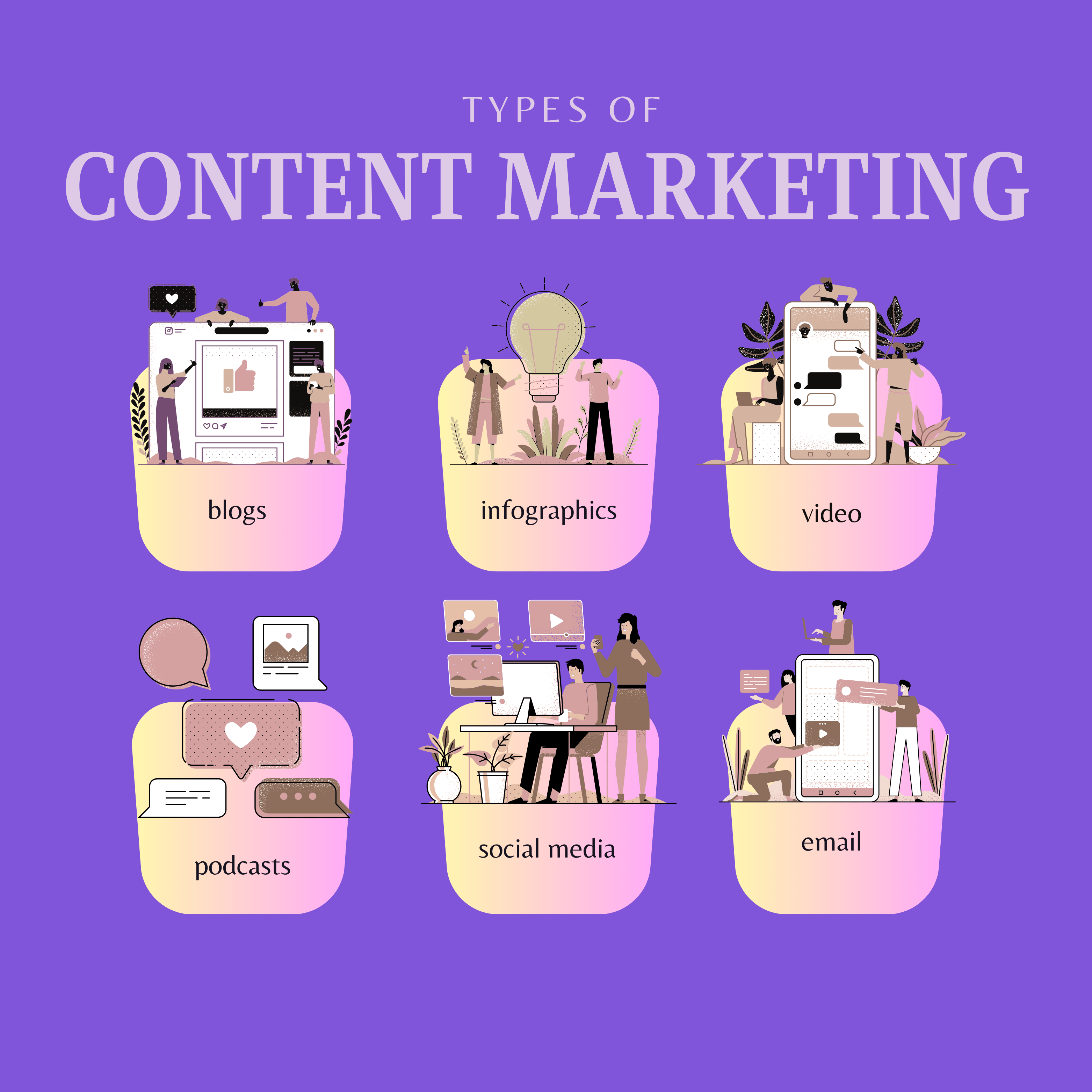Content Marketing: The Ultimate Guide to Growing Your Online Presence
Introduction
Content marketing is a strategic marketing approach focused on creating, distributing, and promoting valuable, relevant, and consistent content to attract and engage a target audience.
Instead of directly selling products or services, content marketing provides helpful and informative content that solves problems, educates, and builds trust with potential customers.
The ultimate goal is to drive profitable customer actions, such as increasing brand awareness, generating leads, and boosting conversions. Content marketing includes blogs, videos, infographics, social media posts, email newsletters, podcasts, and more.

Why Content Marketing is Important?
1. Builds Trust and Authority
People trust brands that provide helpful content. When businesses offer valuable insights, customers see them as reliable sources of information, making them more likely to engage.
2. Improves SEO and Website Traffic
Search engines reward websites with high-quality content. By using content marketing, businesses can rank higher on search engines, leading to increased organic traffic.
3. Generates Leads and Conversions
Educating potential customers through content makes them more likely to convert. Blog posts, eBooks, and case studies guide prospects through the buyer’s journey.
4. Enhances Customer Engagement
Engaging content keeps audiences interested and encourages interaction, whether through comments, shares, or discussions.
How Content Marketing Works?
It works by delivering relevant content at different stages of the customer journey:
- Awareness Stage – Blog posts, videos, and social media content introduce problems and solutions to potential customers.
- Consideration Stage – Webinars, case studies, and product comparisons help users evaluate their options.
- Decision Stage – Testimonials, reviews, and personalized emails persuade customers to take action.
By understanding audience needs and providing valuable content, businesses can nurture leads and turn them into loyal customers.
Types of Content Marketing

1. Blog
Blog is a strategy that involves creating and publishing high-quality, informative blog posts to attract, engage, and convert potential customers. It is one of the most effective and widely used techniques that helps businesses establish authority, drive organic traffic, and improve search engine rankings.
A well-optimized blog provides value to readers by addressing their pain points, answering their questions, and offering solutions related to a particular industry or niche. This builds trust and encourages visitors to take action, such as subscribing to a newsletter, signing up for a service, or making a purchase.
Benefits of Blog :
2. Video
Video is a digital marketing strategy that involves creating and sharing engaging videos to promote a brand, educate an audience, and drive customer engagement. Instead of relying solely on text-based content, businesses use videos to communicate messages more effectively, making information easier to understand and more memorable.
With the rise of platforms like YouTube, Instagram, TikTok, Facebook, and LinkedIn, video content has become one of the most powerful tools for reaching and influencing audiences. Videos can be used for brand storytelling, product demonstrations, customer testimonials, tutorials, live streams, and much more.
Benefits of Video :
- Increases Engagement – Videos are visually appealing and keep audiences hooked.
- Boosts Conversions & Sales – Well-crafted videos influence buying decisions.
- Improves SEO – Google prioritizes video content, leading to better search rankings.
- Enhances Brand Awareness – Viral videos help businesses reach a wider audience.
- Builds Trust & Credibility – Authentic, informative videos establish brand authority.
3. Social Media
Social media is a digital marketing strategy that involves creating and sharing engaging content on social media platforms to attract, educate, and convert audiences. It helps businesses build brand awareness, connect with their target audience, and drive traffic to their websites.
Popular platforms for social media marketing include Facebook, Instagram, Twitter (X), LinkedIn, YouTube, Pinterest, and TikTok. Businesses use these platforms to share various content types, including images, videos, infographics, blog links, live streams, and interactive posts.
Why is Social Media Important?
- Increases Brand Awareness – Reaching a wider audience through viral content.
- Boosts Engagement – Encourages likes, comments, shares, and discussions.
- Improves Customer Trust – Engaging with followers builds relationships and credibility.
- Enhances Lead Generation & Sales – Social ads and organic content help convert followers into customers.
4. Email Content Marketing
This strategy involves sending valuable and relevant content to a targeted audience through email. It is one of the most effective ways to nurture leads, build customer relationships, and drive conversions. Unlike traditional promotional emails, email focuses on providing useful information, personalized recommendations, and engaging storytelling to keep subscribers interested.
Why is Email Content Marketing Important?
- Direct Communication with Audience – Emails reach users personally in their inboxes.
- Boosts Engagement & Customer Loyalty – Personalized emails keep customers connected with your brand.
- Drives Conversions & Sales – Well-crafted emails can encourage purchases and lead generation.
- Cost-Effective Marketing Strategy – Email marketing offers high ROI compared to other marketing channels.
- Improves Customer Retention – Regular newsletters help businesses stay top-of-mind.
5. Infographics
Infographics are visual representations of data, information, or knowledge designed to communicate complex concepts in a simple and engaging way. They combine graphics, charts, icons, and minimal text to make content more digestible and visually appealing.
Why Are Infographics Important ?
- Enhance Understanding – People process visuals 60,000 times faster than text.
- Increase Engagement – Eye-catching visuals grab attention and encourage shares.
- Improve SEO – Infographics attract backlinks, boosting search engine rankings.
- Simplify Complex Information – Present data-heavy topics in an easy-to-read format.
- Boost Social Media Reach – Highly shareable content that increases brand awareness.
Where to Use Infographics ?
- Blog Posts – To support text-based content with engaging visuals.
- Emails – To make newsletters more interactive and appealing.
- Social Media – To drive more shares and reach a broader audience.
- Presentations/Webinars – To simplify complex topics for better understanding.
6. Podcasts
Podcasts are audio-based content that businesses use to educate, inform, or entertain their audience. They are typically shared on platforms like Spotify, Apple Podcasts, and Google Podcasts, allowing listeners to consume content on the go.
Why Are Podcasts Important ?
- Convenient and Accessible – Listeners can consume content while commuting, working out, or multitasking.
- Expands Audience Reach – Podcasts attract a global audience, helping businesses build brand awareness.
- Boosts Engagement – Audio content creates a more personal connection with the audience.
- Improves Brand Authority – Thoughtful discussions position businesses as industry leaders.
- Monetization Opportunities – Brands can earn revenue through sponsorships, ads, and premium content.
Where to Use Podcasts ?
- Business Websites – Embed podcast episodes to enhance blog content
- Social Media – Share snippets or highlights to drive engagement.
- Email Marketing – Include podcast links to provide value to subscribers.
- SEO Optimization – Transcribe episodes to improve search rankings.
How Content Marketing Helps Businesses?
- Boosts Brand Awareness – Regular content publishing keeps your brand in front of the target audience.
- Establishes Industry Authority – Providing valuable insights positions your brand as an expert in your niche.
- Drives More Website Traffic – SEO-optimized content attracts organic visitors.
- Increases Customer Retention – Valuable content keeps customers engaged and returning.
- Generates More Leads and Sales – Educating customers builds trust, leading to higher conversion rates.
Steps to Create a Content Marketing Strategy
Creating a successful strategy involves careful planning and execution. Follow these essential steps to build an effective strategy that drives traffic, engages your audience, and boosts conversions.

1. Define Your Goals
Before creating content, identify your objectives. Ask yourself:
- Do you want to increase brand awareness?
- Are you aiming for higher website traffic?
- Is your goal to generate more leads or sales?
.
2. Understand Your Target Audience
To create relevant content, you must know who your audience is. Conduct market research to determine:
- Their demographics (age, gender, location, income, etc.)
- Their interests and pain points
- The platforms they use (social media, blogs, YouTube, etc.)
- The type of content they prefer (videos, blogs, podcasts, etc.)
3. Choose the Right Content Types
Select content formats based on your audience’s preferences and business goals. Common content types include:
- Blog posts – Ideal for SEO and educating audiences
- Videos – Great for engagement on YouTube, Instagram, and TikTok
- Email newsletters – Nurture leads and retain customers
- Infographics – Visually appealing and easy to share
- Podcasts – Build authority and connect with audiences through audio content
4. Plan Your Content Calendar
Consistency is the key . Create a content calendar to schedule blog posts, videos, social media updates, and email campaigns.
- Post at regular intervals (daily, weekly, or monthly)
- Align content with trends, events, and holidays
- Keep a balance between promotional and informational content
A well-structured content calendar helps maintain consistency and engagement.
5. Optimize Content for SEO
Search Engine Optimization, or SEO, is essential to the success of content marketing.To optimize your content:
- Use relevant keywords in titles, headings, and body text
- Optimize images with alt text
- Write compelling meta descriptions
- Add internal and external links
- Improve readability with short paragraphs and bullet points
Optimized content ranks higher on search engines, increasing visibility and traffic.
6. Distribute and Promote Your Content
Creating great content is not enough; you must promote it effectively. Share your content on:
Social media: Twitter, LinkedIn, Instagram, and Facebook
Email newsletters – Send valuable insights to subscribers
Influencer collaborations – Partner with industry experts
Guest blogging – Write for other websites to expand reach
The more places you share your content, the more engagement you will generate.
7. Measure and Improve Your Strategy
Track your content’s performance using analytics tools like:
Google Analytics – Measure website traffic and conversions
Social media insights – Track likes, shares, and engagement
Email marketing tools – Analyze open rates and click-through rates
Content Marketing Tips

Expert Tips for Content Marketing Success
- Focus on quality over quantity – well-researched, valuable content performs better.
- Use storytelling to make content relatable and engaging.
- Repurpose content across different platforms to maximize reach.
- Keep content visually appealing with images, videos, and infographics.
- Stay updated with the latest content trends and search engine algorithms.
Frequently Asked Questions (FAQs)
Conclusion
Content marketing is a powerful strategy that helps businesses engage audiences, build trust, and drive long-term growth. By using the right content formats, optimizing for SEO, and delivering value to customers, businesses can create a strong online presence.
Implementing a well-planned strategy can significantly improve brand awareness, customer loyalty, and business revenue. Whether you’re a small business or an established brand, investing in content marketing is a must for digital success.
